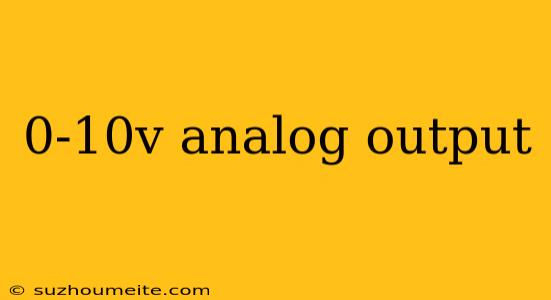0-10V Analog Output: Understanding the Basics
In the world of industrial automation, analog output signals play a crucial role in communicating measurements and control signals between devices. One of the most common analog output signals is the 0-10V output, which is widely used in various industrial applications. In this article, we will delve into the basics of 0-10V analog output, its applications, advantages, and limitations.
What is 0-10V Analog Output?
A 0-10V analog output is a type of analog signal that represents a continuous range of values between 0 volts and 10 volts. This signal is typically used to transmit information from a sensor or transmitter to a control device, such as a programmable logic controller (PLC) or a distributed control system (DCS). The 0-10V output is usually represented by a linear scale, where 0V corresponds to 0% of the measured value, and 10V corresponds to 100% of the measured value.
Applications of 0-10V Analog Output
0-10V analog output is widely used in various industrial applications, including:
Process Control
In process control applications, 0-10V analog output is used to transmit signals from sensors measuring temperature, pressure, flow rate, and level. These signals are then used to control valves, pumps, and other actuators to maintain a stable process.
Automation Systems
In automation systems, 0-10V analog output is used to transmit signals from sensors and transmitters to control devices, such as PLCs and DCSs. These signals are then used to control motors, valves, and other actuators.
Measurement and Testing
In measurement and testing applications, 0-10V analog output is used to transmit signals from sensors and transducers measuring physical parameters such as temperature, pressure, and vibration.
Advantages of 0-10V Analog Output
The 0-10V analog output has several advantages, including:
Easy to Implement
0-10V analog output is a simple and widely used standard that is easy to implement and integrate with various control devices.
Accurate and Reliable
The 0-10V analog output is a continuous signal that provides accurate and reliable measurements, making it suitable for critical industrial applications.
Wide Compatibility
0-10V analog output is compatible with a wide range of control devices, making it a versatile option for industrial automation applications.
Limitations of 0-10V Analog Output
While the 0-10V analog output is widely used and versatile, it does have some limitations, including:
Noise Susceptibility
The 0-10V analog output is susceptible to electromagnetic interference (EMI) and radio-frequency interference (RFI), which can affect the accuracy of the signal.
Attenuation
The 0-10V analog output signal can be attenuated over long distances, which can result in signal loss and degradation.
Limited Resolution
The 0-10V analog output has a limited resolution, which can limit its ability to accurately measure small changes in the measured parameter.
In conclusion, the 0-10V analog output is a widely used and versatile signal standard in industrial automation applications. Its ease of implementation, accuracy, and reliability make it a popular choice for process control, automation systems, and measurement and testing applications. However, its limitations, such as noise susceptibility, attenuation, and limited resolution, should be considered when designing and implementing industrial automation systems.
